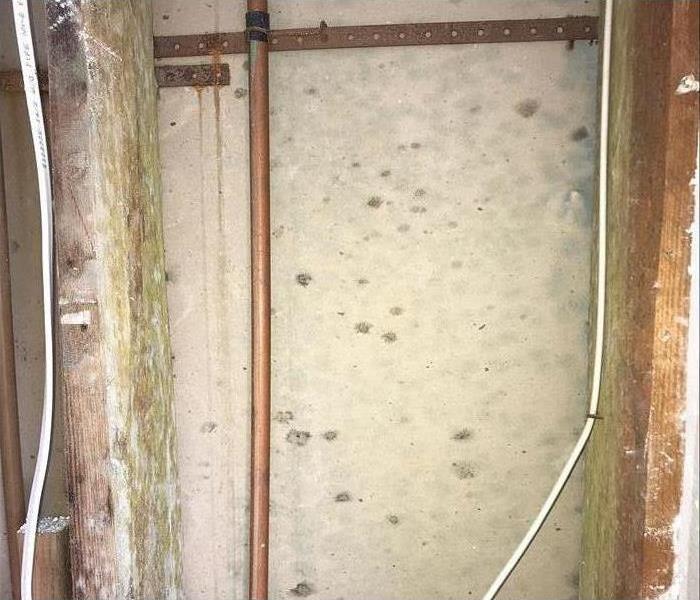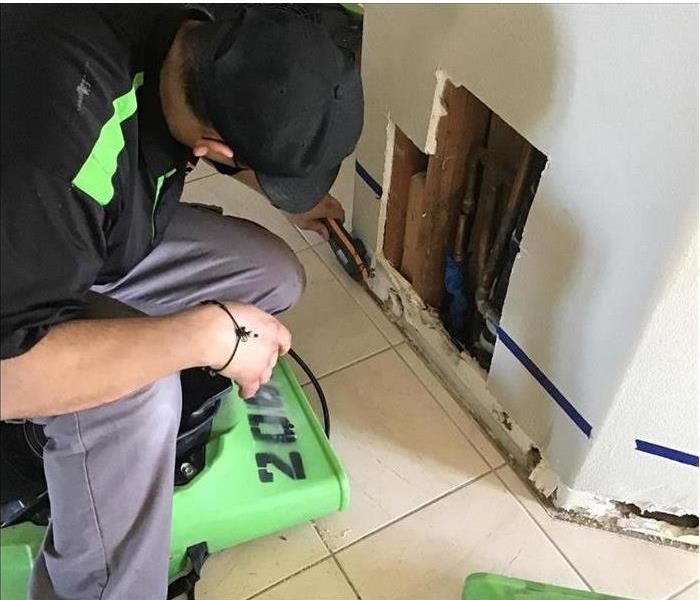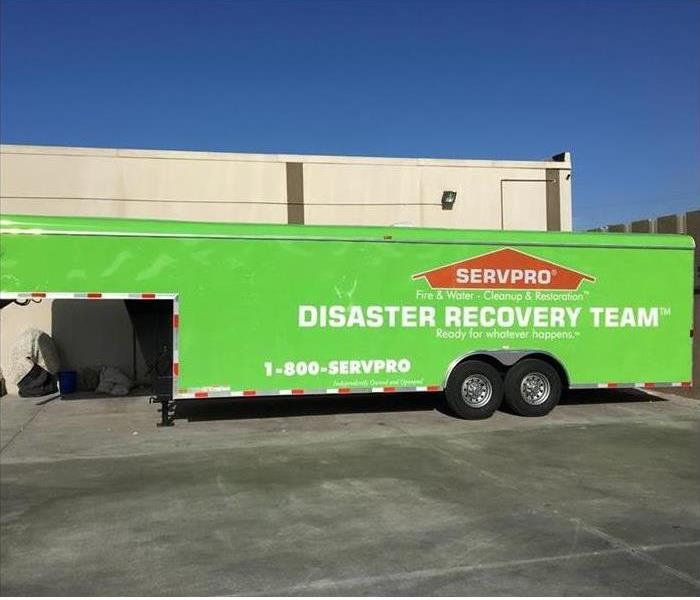Archived Why SERVPRO Blog Posts
How Do I Get Rid of Mold Damage?
12/5/2022 (Permalink)
 Mold inside of your walls will cause many issues
Mold inside of your walls will cause many issues
How Do I Get Rid of Mold Damage?
Mold is a type of fungus that grows in warm, damp environments. If you see mold or suspect it's present in your home or workplace, you should take action to get rid of it. This article explains how to assess and remove mold safely.
Choose a remediation contractor.
Once you've identified the extent of your mold damage, you'll need to choose a contractor to remove it. If possible, hire someone who has been in business for several years and can provide references from customers they've worked with. Ask these references about their experience and whether they would hire this company again. Also ask if the company owner was present during all stages of the job, as well as if they have certification in environmental science or other areas related to mold remediation (such as building construction). It's also wise to get proof that your chosen company has insurance coverage in case anything goes wrong during their work on your property.
Remediation work plan.
A remediation work plan describes the work to be done, the equipment and materials to be used, and procedures to be followed. It should include:
- A detailed description of the problem area(s)
- Steps for containing the mold
- Steps for removing mold from building materials and furnishings (if applicable)
- Procedures for cleaning up after removing mold (e.g., disposing of waste materials).
Personal protective equipment (PPE)
The use of Personal Protective Equipment (PPE) is required when dealing with mold. PPE for individuals includes a respirator, gloves, and goggles. A respirator can be useful when handling moldy materials, but it is not required by OSHA now. Gloves should be worn any time that you are handling contaminated materials because even healthy people can become ill from exposure to molds. Goggles or glasses should always be worn when working with moldy materials as they will protect your eyes from any airborne spores that may be released into the air during cleaning and removal.
Containment
Containment is a crucial step in the mold removal process. If you don't contain the mold, then it can easily spread to other areas of your home and cause more damage than necessary. Containing the mold means keeping it from spreading while you work on removing it. You can use barriers (like plastic sheeting) to keep the mold confined to one area, or you can remove items that have been affected by moisture and put them into another room until they are cleaned and disinfected.
If you decide to use plastic sheeting for containment purposes, make sure that there are no holes in between pieces of plastic so that air doesn't get through them as well! Cover all surfaces affected by moisture with heavy-duty plastic sheeting.
Mold removal
Mold removal is a multi-step process, but it doesn't have to be overly complicated. For example, if you find mold growing in your bathroom, you should use a HEPA vacuum to remove as much of the mold spores as possible. Next, scrub the affected area with a brush dipped in soap and water. Use an all-purpose cleaner if you want to make sure that no mold remains after scrubbing. You can also use a commercial product designed specifically for removing mold from surfaces like drywall and cement board - these products are available at hardware stores or online retailers such as Amazon.
Disinfectants and antimicrobials
Disinfectants and antimicrobials are often used to kill mold and mildew. However, they are not effective against mold spores. Therefore, it is important for you to use these treatments properly to avoid any potential health hazards that could be caused by their misuse.
The main difference between disinfectants and antimicrobials is how long they remain active after being applied. Disinfectants kill most microorganisms within a short period of time (usually 30 minutes), while antimicrobials only slow down growth of some types of molds (such as Aspergillus) but not all types—particularly those that produce black colony growth.
Be sure you hire reputable professionals, take precautions, and follow your remediation plan.
Mold removal can be an intimidating process. It’s important to remember that you don’t have to do it alone.
We recommend hiring a professional with experience in mold remediation and EPA approval, but there are other important things to look for as well:
- The contractor should have experience in the area where you live (for example, if you live on the coast, your contractor should be familiar with flooding).
- If possible, work with someone who has experience in your type of building (for instance if you live in an old house or trailer).
Mold is a natural part of the world around us. It’s important to know that you can protect yourself from mold and mold damage. If you do find mold in your home, be sure to contact a professional for help in removing it. The EPA has put together some great resources on how to remove mold from your home safely, but if you still have concerns about what to do next then please contact us today! We will answer any questions or concerns that may arise during this process and make sure everything goes smoothly!
Different Types of Contaminated Floodwater
7/6/2022 (Permalink)
Different Types of Contaminated Floodwater
If your client is dealing with flooding in Wimbledon Village, CA, it is important to assume that the flood is composed of contaminated water. Whether the excess originated from a leaky roof or a broken supply line, the water may contain dangerous chemicals and pathogens. One of the best ways you can help your clients is by learning about the different contamination types that commercial building restoration services handle.
Category 1
Water under this category is known as clean water. This type of water is the least harmful due to its sources lacking a significant amount of bacteria or contaminants.
- Defective appliances
- Rainwater and snow
- Water from toilet tanks
- Overflowing sinks and tubs
- Damaged pipes
However, just because this water is relatively safe does not mean it is harmless. If left alone, it can damage commercial property and lead to mold growth. Immediate cleanup and repair are recommended.
Category 2
Category 2 contaminated water requires a stronger response by restoration companies like SERVPRO. Also known as gray water, it originates from sources that add chemicals to the water, such as toilets, dishwashers, washing machines, and more. Exposure to this tainted fluid can make people sick or uncomfortable, and prolonged existence can escalate the contamination to Category 3. Professionals need to remove and restore or dispose of affected material as soon as possible.
Category 3
The most severe type of flood is Category 3, also known as a black water flood. The water that makes up this flood is considered extremely dangerous because it comes from sources like sewers, rivers, ground-level bodies, and other similar places. These locations have a high number of bacteria, pesticides, and other components that can threaten the lives of your clients' customers and employees. A professional flood recovery company can help keep your clients' property safe.
Not all contaminated water is the same. Remediation specialists working in Wimbledon Village, CA, businesses need to know the specific categories to use the right equipment and tactics for the job.
Water Mitigation Expectations After a Water Heater Leak
6/16/2022 (Permalink)
Expectations for Water Mitigation Following a Water Heater Leak
When it comes to insurance claims, water damage ranks second place. Among the various reasons a customer in Mesa Verde, CA, may file this type of claim is a leaking water heater. Since the damage is often a result of a slow leak, the damage can be far-reaching.
Damage Caused by a Broken Water Heater
Although built to last, the essential water heater is prone to aging and rusting which could lead to a leak or sudden burst. Once the problem is discovered, it may have already created a vast amount of damage that can include:
- Carpet Damage: If there has been a slow leak, it likely means that water has been seeping into carpeting for more than 48 hours. After that period, the leak creates additional issues that usually require replacing the carpet.
- Mold Damage: A leaking water heater creates an ideal environment for mold to flourish. Along with forming in carpet, mold can quickly spread to unaffected areas of the property, including the heating, ventilation and air conditioning system. If that happens, mold spores can easily find a new home and create a massive mold problem.
- Flooding Damage: A sudden burst will unleash excessive amounts of water into the property. Along with damaging the flooring, this standing water will begin to seep up into the baseboards and walls, which can result in structural issues.
Water Mitigation Expectations
Once a failed water heater causes damage, it is vital to get the issue taken care of immediately. Choosing a certified water mitigation company means getting a team experienced in reducing damage and property loss. A professional team will also have the know-how to address the specific restoration needs in each unique situation. The cleanup process typically involves:
- Stopping the source of the issue
- Beginning the water extraction process
- Drying out the property
- Cleaning and sanitizing affected areas
- Repairing the damage and restoring the property to preloss condition
A leaking water heater has the potential to cause more damage than seems possible. To minimize the damage, the water mitigation process should be started as soon as possible.
Restoration Companies Service Both The Client and The Adjuster
3/3/2022 (Permalink)
 SERVPRO is available 24 hours a day, 365 days a year to assist with any size water loss. Call us!
SERVPRO is available 24 hours a day, 365 days a year to assist with any size water loss. Call us!
Service Provided By Restoration Companies Both The Client And The Adjuster Are Involved.
Is a restoration company working for the client or the insurance adjuster? It's tempting to think that the operation is designed to fight solely for one side. The business relationship, however, is symbiotic, supporting all of the involved parties. Here's what the establishment does and why they're right for everyone.
What Does a Restoration Company Do?
A restoration business is a one-stop-shop for water damage repairs. Designed to serve multiple needs, establishments such as SERVPRO house specialists in various fields, offering assistance throughout an entire project. By having everyone connected to one place, cleanup is streamlined for efficient project management. Organizations start the job and finish it, following through on all of the following demands:
- air and structural testing
- drying methods
- content cleaning
- mold contamination and cleanup
- building repairs
- vent cleaning
How Does This Connection Benefit Owners?
An insurance adjuster requires specific documentation before financial assistance is permitted. When owners use multiple companies to tend to different projects, this complicates matters and slows approval. Remediation crews step in and aid in this process. The specialists from the first moment begin to take photographs and assess the premises, noting conditions within an electronic system. This information is then sent overall as one, saving proprietors time and headache. Owners step back and have someone take over the hassle.
How Does the Service Assist Insurers?
An insurance claim should arrive in the appropriate language and with the necessary support. Armed with this awareness, staff create submissions in the correct format. This avoids rewrites, frustration and delays.
Also, certified professionals determine what is wrong on the property and how the trouble should be repaired. Following national standards, insurers may trust the team to complete the work accurately.
Of course, keeping costs down is vital. A water restoration company arrives immediately to secure and contain the premises. These actions and the effort to salvage what is possible reduce the overhead.
A claim doesn't have to be a battle between the insurance adjuster and owner. When a remediation company is hired, communication improves, and workload lessens, creating a desirable collaborative union for commercial owners and insurers.
CIC and ReportER: How SERVPRO Is Helping the Insurance Industry
2/2/2022 (Permalink)
 Day or Night. Holiday or Business Day. We have your back if catastrophe strikes. Call SERVPRO when you need it!
Day or Night. Holiday or Business Day. We have your back if catastrophe strikes. Call SERVPRO when you need it!
How SERVPRO Is Assisting the Insurance Industry with CIC and ReportER
Researching an insurance claim is a large part of an insurance adjuster’s job, and that process can be slowed down by unreliable sources or other time-consuming issues. While there are many ways for an agent in the Costa Mesa, CA, area to verify and estimate payout, using the CIC system through SERVPRO is likely the quickest and most reliable way to go.
1. Claims Storage and Organization
For an insurance agent, it is about receiving reliable information and being able to get that information in a quick and organized way. The CIC, or Claims Information Center, gives agents the ability to search for claims by type and location within one platform, meaning that they can perform tasks quicker and more efficiently.
2. Database and Structure
The database is called ReportER and is accessed through the Managed Dashboard, allowing agents to use the CIC. These tools provide the necessary structure for the CIC to be not only useful but effective. Insurers are able to upload an insurance claim and check the progress throughout the life of the restoration.
3. Accessibility and Ease of Use
The entire system that SERVPRO has developed is designed to simplify the claims process for agents and making it approachable through the Managed Dashboard. It is here that insurers can review claims and other working projects, allowing them to compile all significant information in one place.
The research involved in the insurance claim process can be incredibly time-consuming, but when an agent is inundated with unreliable sources, the process becomes unproductive. To ensure that an agent is equipped with the right data sets, it is important for them to start with the right tools, but more importantly, it is necessary to be able to track their progress. The Claims Information Center allows for all this and more. With the incorporated Managed Dashboard and the ReportER database, an agent has everything they’ll ever need.






 24/7 Emergency Service
24/7 Emergency Service


